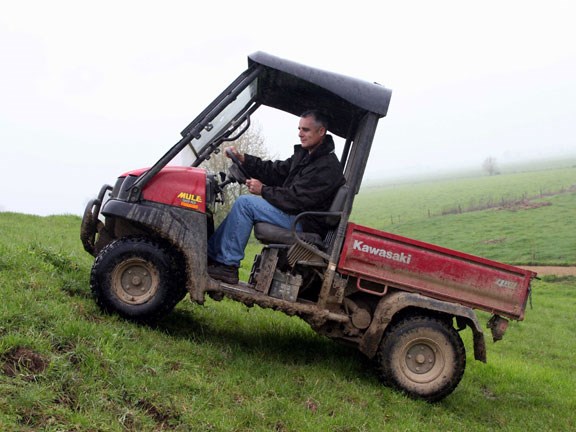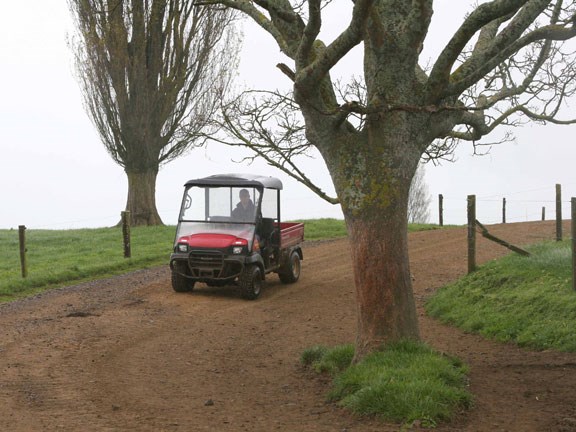Kawasaki Mule 3010 ATV









|

|

|

|
Ride-on ATVs are gaining in popularity and offer a number of advantages that a normal quad can’t give

|
|
Kawasaki Mule 3010 ATV
|
The great thing about ride-on ATVs is they are generally much more versatile with a large tipper tray and two people can fit on the bench seat.
Our test Mule is only six-months old but already it has proved its worth on George Peake’s Ohaupo dairy farm.
Sons Carey and Wayne also work the farm and two years ago, bought a brand new 500cc ATV, which they basically killed in that time! The frame broke in several places for starters, but they freely admit to overworking their ATV by towing heavy trailers, a mini spreader and the like. Recognising this fact, they decided a heavier ride-on would suit their needs better. Carey says they can now head out to repair a fence with just the one vehicle, rather than a farm bike and an ATV. He likes it for other reasons too.
"The deck is great for throwing your fencing gear and tools on, and the extra seat is handy. It also has storage cubbies to store medicine for sick cows."
Power is the Peake’s only issue with the petrol Mule.
"It would be nice if it had a little bit more power, such as when I have a trailer full of calves! I think it has done an admirable job so far though," says Carey.
I tested the fairly powerful diesel engined Mule in early 2008, so testing the petrol version was a great opportunity to compare the two. My test was very worthwhile as I found a number of important differences.
Probably the most significant was the lack of real power from the liquid cooled 617cc V-twin petrol driven motor. The 3010 model has a Mikuni carburettor. The advertised 20hp got the Mule up small slopes ok with two big people and it gets around the farm well too, but I feel it just lacks that extra grunt other ride-ons offer. It was most noticeable when I put my foot down hard and found there was a delayed response before the engine picks up revs and drives the 580kg Mule forward.
Fortunately, Kawasaki addressed this issue shortly after my test, with the NZ introduction of the restyled 4010, replacing the 3010 in this test.
Using the same V-twin petrol powerplant, Kawasaki has thrown out the carburettor and fitted fuel injection with dual throttle valves, which should give the 4010 the extra power and crisp throttle response the 3010 lacked. The ECU controlled fuel injection system automatically compensates for altitude changes plus air and engine temperature variations. The engine is easier to start and will be more economical too. It’ll cost a bit extra, but go for the diesel 4010 model if you plan to do any towing or heavier type work with the Kawasaki Mule.
Getting the 3010 petrol Mule into gear was my biggest issue. Even with over 500 hours on the clock and its service due, it still shouldn’t crash the gears when putting it into either high or low ratio with the engine at idle speed. It was significantly worse in high, but when I first put it into reverse, the Mule literally took off on me!
Almost every vehicle I test has its own ‘special’ way of being operated. With the 3010, I took time to play around with the gears and discovered the Mule’s secret.
When I treated the gearbox with authority and a bit of speed, I could engage the gears without crunching them. Working the step-less drive transmission, I could place it into 4WD on the fly, and just as easily back into 2WD.
When I took it up a reasonably steep slope on wet grass, the wheels began to spin as I expected. But the diff lock made no difference to performance, and in the end I had to reverse down the hill and get a run-up to make it to the top.
Although heavy in the steering, the in-paddock turning circle appeared to be about the same in 2WD or 4WD.
Again, Kawasaki sorted the steering issue out with the new 4010 model. An electrically-operated speed sensitive power steering unit is now included as standard, which will undoubtedly make driving that much more effortless.
The brakes on the 3010 were quite effective; however I spent some time on a downhill slope trying to find out if the petrol Mule disengaged its engine braking when the engine speed got down to idle. Thankfully this model Kawasaki Mule offered engine braking at all times when driving downhill, a very important feature for any ride-on ATV.
After wearing out their $14,000 500cc ATV within two years to the point they only got $2000 from the wreckers, the Peake’s certainly made the right decision by going to a ride-on ATV.
An optional windscreen was fitted to compliment the roof.
George adds that creature comfort comes into it too.
"It’s very handy to be able to sit inside when writing in my notebook. I no longer have to deal with wet paper. Overall it is far superior to an ATV."
Keep up to date in the industry by signing up to Farm Trader's free newsletter or liking us on Facebook



.jpg)



.jpg)
.jpg)
.jpg)

